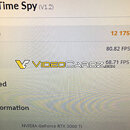Thursday, November 26th 2020

NVIDIA GeForce RTX 3060 Ti Fire Strike and Time Spy Scores Surface
3DMark scores of the upcoming NVIDIA GeForce RTX 3060 Ti were leaked to the web by VideoCardz. The RTX 3060 Ti was put through standard 3DMark Fire Strike and Time Spy benchmark runs. In the DirectX 11-based Fire Strike benchmark, the card allegedly scores 30706 points, with 146.05 FPS in GT1 and 122 FPS in GT2. With the newer DirectX 12-based Time Spy test, it allegedly scores 12175 points, with 80.82 FPS in GT1, and 68.71 FPS in GT2. There are no system specs on display, but the scores put the RTX 3060 Ti slightly ahead of the previous-generation high-end GeForce RTX 2080 Super.
The GeForce RTX 3060 Ti, bound for a December 2 launch, is an upcoming performance-segment graphics card based on the "Ampere" architecture, and is carved out of the same 8 nm "GA104" silicon as the RTX 3070. It reportedly packs 4,864 "Ampere" CUDA cores, 38 second-gen RT cores, 152 third-gen Tensor cores, and the same memory configuration as the RTX 3070—8 GB of 14 Gbps GDDR6 across a 256-bit wide bus. NVIDIA is targeting a "<$399" price-point, making the card at least 43% cheaper than the RTX 2080 Super.
Source:
VideoCardz
The GeForce RTX 3060 Ti, bound for a December 2 launch, is an upcoming performance-segment graphics card based on the "Ampere" architecture, and is carved out of the same 8 nm "GA104" silicon as the RTX 3070. It reportedly packs 4,864 "Ampere" CUDA cores, 38 second-gen RT cores, 152 third-gen Tensor cores, and the same memory configuration as the RTX 3070—8 GB of 14 Gbps GDDR6 across a 256-bit wide bus. NVIDIA is targeting a "<$399" price-point, making the card at least 43% cheaper than the RTX 2080 Super.


31 Comments on NVIDIA GeForce RTX 3060 Ti Fire Strike and Time Spy Scores Surface
you are making a mistake with thinking the arbitrary nomenclature nvidia uses is etched in stone or something. it doesn't matter what the card is named; what matters is the chip (ie. x02, x04, x06). and bitching about nvidia's shell game is almost a decade too late - refer to since kepler or you can quickly look at the 2060/2060S chips and start seeing it. (but yeah 2060 was a complete pile of garbage for any price).
you are preaching to the choir but have the wrong sermon. :p
Some tech youtubers say the masses will have access to these newer cards much much later, months into 2021.
But some people feel more entitled than others.
All that they have done is introduce new models to go in between the existing ones in the mid-high price segment.
Please at least try to be coherent if you want to take this further.
definitively not the best time to buy a new GPU.
960 wasnt $400 it was $200, 1060 wasn't $400 was $250.
And seeing how the $499 3070 is about $800 if you can get it in europe, i doubt you will be able to get a 3060 for $400. I got my 960 for $200 from the store.
A whole system PS5 or new Xbox is being sold for $500 and has a low-mid to mid range gpu inside. Admittedly it is being sold at cost, but this just outlines how badly they are fcking the custom PC market with these prices.
2010 - GTX 460: $199
2010 - GTX 465: $279
2011 - GTX 560: $199
2011 - GTX 560Ti: $289
2012 - GTX 660: $230
2012 - GTX 660 Ti: $300
2013 - GTX 760: $249
2013 - GTX 760 Ti: OEM-Release
2015 - GTX 960: $199
2016 - GTX 1060 3GB: $199
2016 - GTX 1060 6GB: $299
2019 - RTX 2060: $349
2019 - RTX 2060 S: $399
TBA (2020) - RTX 3060: TBA ($349)
TBA (2020) - RTX 3060 Ti: TBA ($399)
Further, NVIDIA is not really jumping on cutting edge nodes either. They have gone with rather established fabrication processes more or less.
I also don't think that R&D is massively breaking the bank either, but I don't have a source at hand to show that.
Sure! It is a business, it has to generate profits for shareholders. However one can't deny, that the money from 2010 adjusted for inflation ($279 ~> $330) is not buying you the equivalent tier hardware in 2020.
I'm curious how the 3060 Ti slots in with real game benchmarks and what 2021-2022 will bring to the midrange, now that AMD and NVIDIA are head to head on the full line up again.
The x60 split had nothing to do with RT capability, that was dome because 2080 was so fast, it left a gap behind it that fit one more SKU that usual. Of course, Nvidia dropped the ball hard (like, really hard) with their naming scheme that included two x60 parts :( If they renamed their cards like 2060->2070, 2070->2080 and 2080->2090, they would have spared everybody a lot of grief.
Coming up with performance tiers would also be kinda subjective, as would just setting price tiers and compare performance over generations.
SKU was the quickest choice which was also defined by NVIDIA, since the naming scheme should function as a way of orientation for customers.
I do agree, that it is not perfect either!
Why they did not go with a new SKU x90 or simply repeated the previous system of: Titan > x80 Ti > x80 > x70 Ti > x70 >... only NVIDIA knows.
Going out on a limb here, I remember the Steve's (Gamers Nexus and Hardware Unboxed) reaching out to NVIDIA on release for a statement on the 16xx SKU and only receiving vague PR speech about differentiation of RTX support or the lack thereof.
Sorry for going so far off-topic regarding the thread.